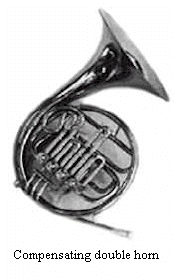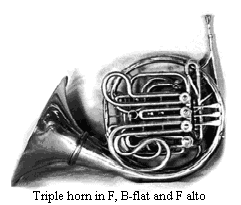 |
A Brief History of Horn Evolution
4. Doubles, Descants and Triples
 The Compensating Double -- The Compensating Double --
Double horns were developed by Edmund Gumpert and Fritz Kruspe in the late 1800s.
The first double horns were based on a system of adding tubing which compensated for
the different lengths between the F and the B-Flat horns. Today we call them
"compensating" double horns to distinguish them from full double horns, which
came about a short time later. The full double is by far more popular today, but
compensating horns are still used by some hornists. Compensating horns are more
difficult for some players to play in tune, but others prefer them because of their
lighter weight - a result of the fact that there is much less tubing in the compensating
horn than in a full double.
In most compensating horns, when the thumb valve is pressed, it
directs the air through a length of tubing that produces the B-flat harmonic series, i.e.
it is a B-flat horn. Each of the three valves, when pressed, then direct the air
through additional tubing to lower the pitch by the correct amount, e.g. the first valve
lowers it one step, second lowers it one-half step, and third lowers it one and a half
steps. The three valve slides are exactly the correct length to lower the B-flat
horn the proper interval.
When playing on the F horn side of a compensating horn, the
air still goes through the B-flat horn tubing as before, but now it also goes through an
additional length of tubing that makes it the correct length to produce the F harmonic
series, i.e. now it is an F horn. Because the length of an F horn is longer than a
B-flat horn, there is another set of three short slides (one on each valve) to
"compensate" for the different length of the F horn. When using the three
valves, the air travels through the existing B-flat horn valve slides and
the additional short, "compensating" slides. |
The Full Double --
A full double horn is two complete horns built into one
instrument, both horns sharing the same leadpipe and the same bell. After the
leadpipe, the instrument contains a short length of tubing for the B-flat horn, and a
completely separate, and longer, length of tubing for the F horn. The thumb valve
again determines if the air goes through the B-flat horn or the F horn, but unlike the
compensating horn, it does not go through both sets of tubing at the same time. (note: On
most doubles, the thumb valve up will be F horn, the thumb valve down will be B-flat
horn. There are some players though, who have their instruments set up so that this
is reversed - thumb up is B-flat, thumb down is F.)
On the full double there are also two complete sets of slides for
the three valves - one set for the B-flat horn, and another set for the F horn. When
the thumb valve sends air into the B-flat horn, the three valves will send air only into
the slides that are the correct length for the B-flat horn. When the thumb valve
sends air into the F horn, the three valves will send air only into the slides for the F
horn. So instead of adding a little bit of extra tubing to the existing B-flat horn
slides, the F slides are completely separate from, longer than, and never used at the same
time as the B-flat horn slides.
Descants --
Around 1900, smaller single horns pitched one octave above the
standard F horn began to appear in Germany. These small-belled horns with small
bores were pitched in High F (also called F alto) to help hornists tackle the
high-register demands of Baroque repertoire. Known as "descant"
(meaning "soprano") horns, these instruments will not provide a hornist with an
automatic high range. If a player does not have the ability to play in the upper
register, a descant horn will not suddenly endow the player with that ability.
A descant does however mean that the high notes are lower in the
natural harmonic series of that instrument.
For example, a written high C for horn in F, when played on the
regular F horn, is the 16th note in the harmonic series, with the next harmonics only a
half step away. On an F alto horn, that same note is the 8th harmonic, with the next
harmonics a whole step away. The extra half step can make a big difference in the
accuracy and ease of playing the high notes. Imagine being in a shooting gallery
aiming at small targets that are very far away, yet huddled closely together with other
small targets. Playing clarino parts, high and brilliant - like the Bach Brandenburg
Concerto - on a descant horn is like suddenly moving your targets twice as close as
playing on a regular double horn.
Though it is the same sounding pitch, on the descant horn,
because the neighboring harmonics are farther apart, it makes it easier to hit the correct
high notes more accurately. There is less likelihood of accidentally hitting one of
the other harmonics (in horn jargon: a "clam").
In the late 1950's Richard Merewether and Robert Paxman
began making double descants - a dual-bore full double horn pitched in F and F alto. Soon
a B-flat/F alto double horn was also created, which allowed the player to use the B-flat
side for most of the range and the F alto side for the extreme high notes.
 Triple Horns
-- Triple Horns
--
Merewether also developed a triple horn that is constructed of
three full sections of tubing - pitched in F, B-flat and F alto. Using hollow valve
rotors, he was able to keep the weight of the instrument down somewhat, but triple horns
are still among the heaviest instruments around. Many principal horn-players in
symphony orchestras today use descant and/or triple horns for added security in the upper
register. |
 CONTINUE... CONTINUE...
This is hornplanet.com
HOME
|| HornPage | St. Louis Brass | Opus 90 | Bacon | Golden Horn
|
Store | Food
|| CONTACT
 |
Copyright © Thomas Bacon
1996 - 2009
All rights reserved |
Site Design by Horndog
www.horndoggie.com |

|
|
 The Compensating Double --
The Compensating Double --  Triple Horns
--
Triple Horns
--